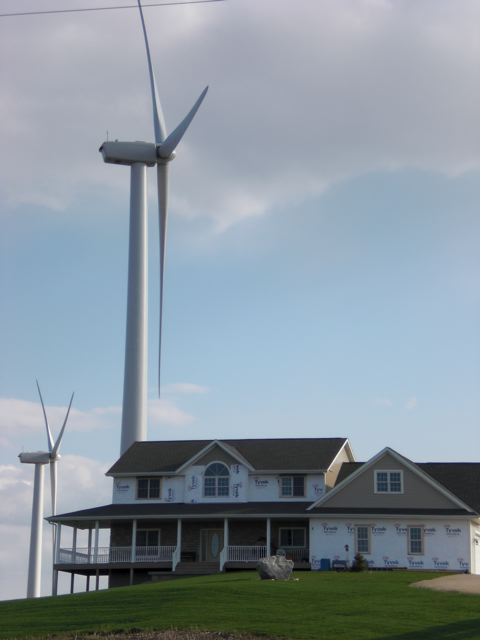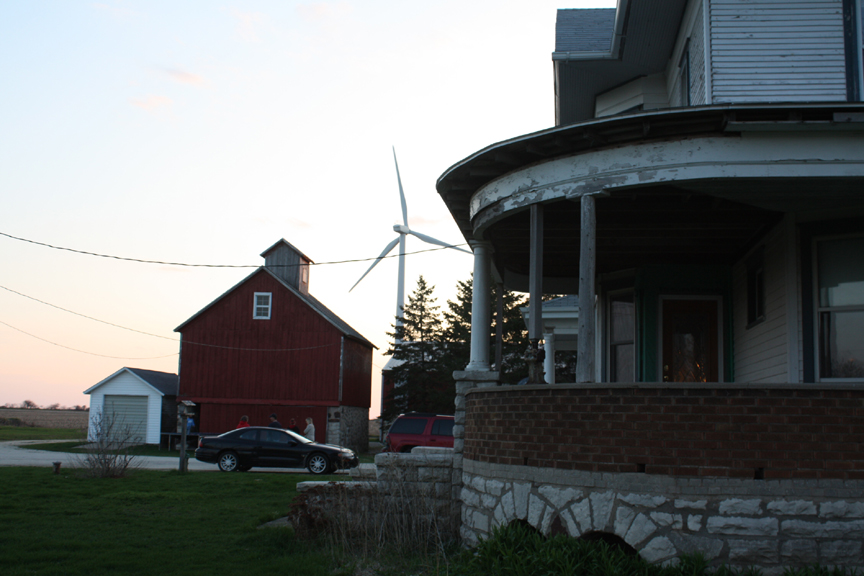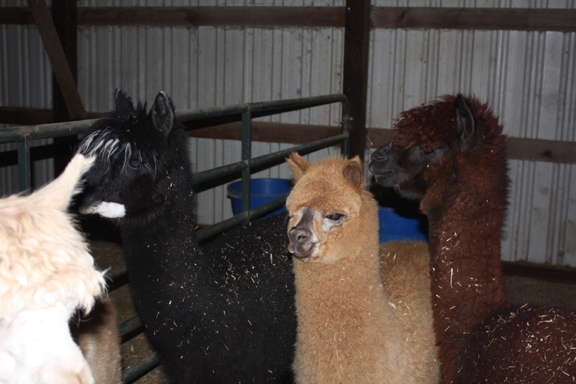5/20/09 It's all in your head: Are you a congenitally unhappy person? How a wind lobbyist explains away your problem with living 1000 feet from an industrial wind turbine. AND the story of a family driven from their Wisconsin home by turbine noise.
 Photo by Lynda Barry: Home in a Wind Farm: Butler Ridge Project, Town of Herman, Dodge County, Wisconsin, May 2009
Photo by Lynda Barry: Home in a Wind Farm: Butler Ridge Project, Town of Herman, Dodge County, Wisconsin, May 2009
In a story published in the Chicago Reader last week, a lobbyist for the wind industry gave us his take on what's really behind the complaints of those living too close to 400 foot wind turbines.
Although we don't agree with this psychological assessment of families who are having trouble living with the PSC-approved setbacks, we present his statement to give you a glimpse into the soul of a lobbyist for Big Wind.
CLICK HERE to read the full story on line.
“You can’t stop a project in Wisconsin based on the appearance of these turbines,” [Michael Vickerman] says, “so over the past seven years the opposition has refined its arguments and framed them in the realm of protecting public health and safety.Here, as far as I’m concerned, is where they reveal their antiwind bias.
They allege that they can’t sleep, they suffer from nausea—they express their discomfort in the most hysterical terms, and I think they basically work themselves into a very visceral hatred for wind.I don’t even know if they have a philosophical objection to wind. They’re maybe congenitally unhappy people and they needed to project their fears and anxieties and resentments onto something new that comes into the neighborhood and disrupts things.”
-Michael Vickerman, as reported by the Chicago Reader, May 14, 2009
We also present the following story from a family living in a PSC approved wind farm with a wind turbine less than 1300 feet from their door.
They spoke to us on the evening of May 2, 2009, at their home which is located in Dodge County near the Town of Oakfield, Wisconsin.
Ann and Jason Wirtz bought their home on June 1st, 1996. It’s a pretty Wisconsin farmhouse near the Town of Oakfield in Dodge County. It’s the kind of place that had people stopping by to ask if the family would consider selling it.
“They’d just pull into our driveway,” says Ann. “There were people who said if we ever decided to sell it, we should call them.”
Although turn-of-the-century house needed a lot of work when they bought it, they didn’t mind. The Wirtz family planned to stay. Ann and Jason both grew up in the area and wanted to raise their children there.
“ I thought we were going to live here for the rest of our lives.” says Ann, a mother of four. “I thought one of our kids was going to live here after us.”
This was before 86 industrial wind turbines went up around their home as part of the Forward Energy wind project which began operation in March of 2008. The closest turbine is to the Wirtz home is less than 1300 feet from their door. Wirtz family home, near Town of Byron, Fond Du Lac County, WIsconsin Photo By Gerry Meyer May 2, 2009“Last night it was whining,” said Ann. “It wasn’t just the whoosh whoosh whoosh or the roaring. It was a high pitched whine. And I don’t just hear them, I can feel them.” She describes feeling like a beat in her head. A pulse that matches the turbine’s rhythm.
Wirtz family home, near Town of Byron, Fond Du Lac County, WIsconsin Photo By Gerry Meyer May 2, 2009“Last night it was whining,” said Ann. “It wasn’t just the whoosh whoosh whoosh or the roaring. It was a high pitched whine. And I don’t just hear them, I can feel them.” She describes feeling like a beat in her head. A pulse that matches the turbine’s rhythm.
“Last night was really bad,” she said.
She says she knows which nights are going to be loud by which way the turbine blades are facing, and her family dreads the nights when the wind is out of the west. “That’s when they are the loudest.”
Jason said he found out there was a wind farm planned for his area from a neighbor he ran into at the post office. “He asked me if I knew anything about the turbines coming in. I didn’t.” Jason came home and mentioned it to Ann.
“When I first heard about it I wasn’t that alarmed.” says Ann, “People were saying how bad they could be, but I just didn’t believe them at first.”
She assumed the turbines would be sited much further away from her home, unaware of the controversy over the setbacks approved by the Public Service Commission of Wisconsin which allows turbines to be sited close as 1000 feet to the homes of people like the Wirtzes.
“All those orange flags they put in were way back there. I was thinking it wouldn’t be too bad. And then when that access road started coming in so close I said, ‘what the heck is going on?’
Meanwhile, Jason had been attending town meetings and learning more about the project. The more he learned, the more worried he became. Five months before the turbines went up, the Wirtz family decided to sell their house.
They called people who had let them know they’d be interested in buying it. “When they found out about the turbines,” said Ann, “They weren’t interested anymore.”
Wirtz family prepared the house to put on the market. In November of 2007, the home, sitting on eight acres, was appraised for $320,000. But this once sought-after property could find no buyers. “As soon as people found out about the wind farm coming in,” says Ann. “That was it. And once they started building the roads to the turbines, forget it. They’d ask what that road was for, we’d tell them and we’d never hear from them again.”
After the turbines went up, interested buyers stopped showing up altogether.
“We tried to find another realtor,” said Ann, “They’d ask ‘is it near the wind turbines?’ and when they found out it was, they wouldn’t even bother to come out to the house to look at it. One realtor told me it wasn’t worth her marketing dollars to even list it because if it was in the wind farm she knew she couldn’t sell it. I mean have you ever heard of a real estate agent turning down a chance to sell a house?”
Another realtor said they would have to price it well under $200,000 to get anyone to even look at it. “At that price we were going to be $50,000 worse than when we started, “ said Ann. “And that didn’t include the 12 years of work we put into the place.”
But the Wirtzes were increasingly anxious to get away from the turbines. While Jason, who works nights, wasn’t having much trouble with the turbine noise, it was keeping Ann and her children from sleeping well at night. They were tired all the time. They were also getting frequent headaches.
And there was trouble with their animals as well. The Wirtz family raise alpaca and have a breeding herd. Ann says the alpaca became jumpy the first day the turbines went on line. “Normally they are so calm. But the day the towers started up, they seemed to panic. They were on their back legs right away.”
Ann says the herd had always been docile and healthy, with no breeding problems. Since the wind farm started up, their temperament has changed and none of the females have been able to carry a pregnancy to full term. “ They’re nervous all the time now. And I can’t prove anything but I do know my animals. And I really felt something was wrong. All the years we’ve had them we’ve never had a problem.”
At night the herd shelters in the large metal shed behind the Wirtz home. When the turbines are loud, Ann says the sound echoes inside the shed and the metal vibrates and hums. “The noise in here gets just unbelievable. When the tin starts to vibrate in here, they can’t stand it. I have to find them a better home. This is torture for them.”
The same turbine noise has driven Ann out of her own bedroom “I can’t stand to be in that room anymore. I don’t sleep at all. My sleep has been terrible.” Instead she sleeps on the couch where a fan on their pellet stove helps counter the turbine noise. “My number one complaint is how tired I am all the time,” says Ann, “I never had that before, ever.”
Says Jason, “We don’t have air conditioning, we didn’t want it and we didn’t need it. In the summer we just opened the windows and let cross breezes cool the house. But the first summer with the turbine noise we had to shut the windows and turn on the fan. We couldn’t stand it.”
After one of the children was recently diagnosed with a severe stress-related illness, the Wirtzes decided they’d had enough. They decided the health of their family was more important than keeping their home, and they are abandoning it.
“Now, after all the trouble we’ve had living here” said Ann, “ If a family showed up and wanted to buy the place and they had kids, I don’t think I could sell it to them. Knowing what I know about living here, I just don’t think I could put another family through this.”
They are now looking for a place in a nearby village. “We were born and raised in the country but we’re thinking of moving to Oakfield because they aren’t going to plop a 400 foot turbine in the middle of the village, says Jason. “And I know I’m going to have to drive by this place every day on my way to work. It’s going to make me sick to see it, but I can’t stay here anymore.”
Ann adds, “I say we move near whoever it is that decides on the setbacks because you know they’ll never have a turbine by their place”
Jason and Ann sit at the dining room table and point out the elaborate woodwork they’d stripped and re-finished by hand. Jason holds a picture of the farmhouse from happier days. Earlier that day they’d met with the people at the bank to let them know they were giving up their home.
Jason says, “At least we’re young enough to start over. My mom, she doesn’t have much money and now she has turbines around her house. She said, ‘This house was my retirement,’ Her and my dad put everything into that house. Now I don’t know what she’s going to do.” Jason says, “The quality of life we had here is just gone.”
“I grew up here, and I loved it here,” Says Jason, “But I don’t any more.”  Part of the Wirtz family Alpaca herd. Photo by Gerry Meyer
Part of the Wirtz family Alpaca herd. Photo by Gerry Meyer
Note from the BPWI Research Nerd: Though the wind industry continues to deny any negative effects on animals caused by wind turbines, click here to read a BBC report which tells a different story.
[Download a copy of this story by clicking here]